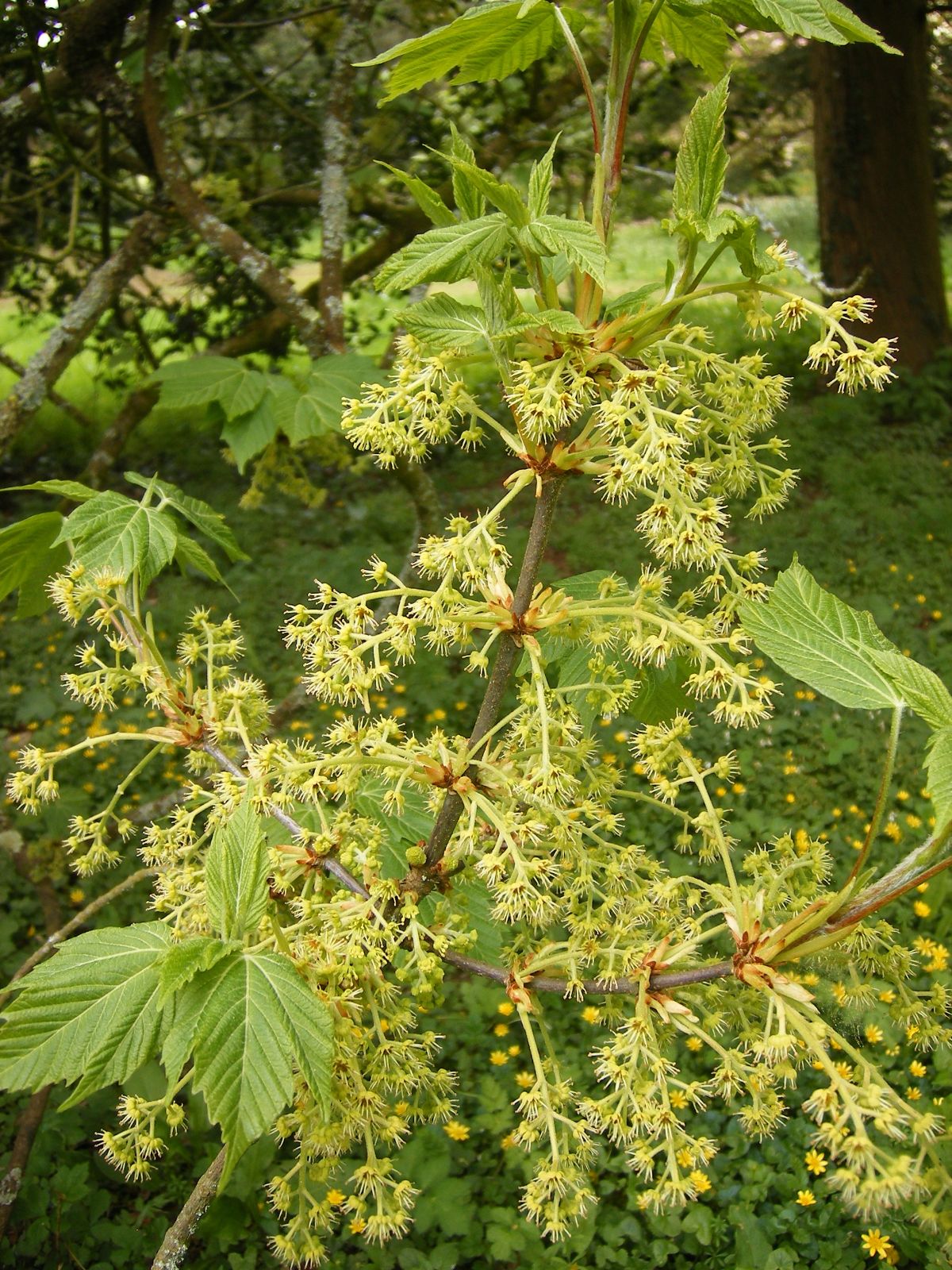Acer franchetii
Sponsor
Kindly sponsored by
a member of the International Dendrology Society
Credits
Article from Bean's Trees and Shrubs Hardy in the British Isles
Recommended citation
'Acer franchetii' from the website Trees and Shrubs Online (treesandshrubsonline.
Genus
Synonyms
- Acer sterculiaceum subsp. franchetii (Pax) E. Murray
Infraspecifics
Other taxa in genus
- Acer acuminatum
- Acer amplum
- Acer argutum
- Acer barbinerve
- Acer buergerianum
- Acer caesium
- Acer calcaratum
- Acer campbellii
- Acer campestre
- Acer 'Candy Stripe'
- Acer capillipes
- Acer cappadocicum
- Acer carpinifolium
- Acer 'Cascade'
- Acer caudatum
- Acer ceriferum
- Acer chapaense
- Acer chienii
- Acer circinatum
- Acer cissifolium
- Acer × conspicuum
- Acer cordatum
- Acer coriaceifolium
- Acer × coriaceum
- Acer crataegifolium
- Acer davidii
- Acer diabolicum
- Acer distylum
- Acer divergens
- Acer duplicatoserratum
- Acer elegantulum
- Acer erianthum
- Acer 'Esk Flamingo'
- Acer fargesii
- Acer fenzelianum
- Acer flabellatum
- Acer forrestii
- Acer × freemanii
- Acer fulvescens
- Acer 'Gimborn'
- Acer ginnala
- Acer glabrum
- Acer 'Gold Coin'
- Acer granatense
- Acer grandidentatum
- Acer griseum
- Acer heldreichii
- Acer henryi
- Acer × hillieri
- Acer hookeri
- Acer hyrcanum
- Acer japonicum
- Acer kawakamii
- Acer komarovii
- Acer laevigatum
- Acer laurinum
- Acer laxiflorum
- Acer lobelii
- Acer longipes
- Acer macrophyllum
- Acer mandshuricum
- Acer maximowiczianum
- Acer maximowiczii
- Acer metcalfii
- Acer miaotaiense
- Acer micranthum
- Acer 'Mindavi'
- Acer 'Minorient'
- Acer miyabei
- Acer miyabei × campestre
- Acer monspessulanum
- Acer morifolium
- Acer 'Mozart'
- Acer oblongum
- Acer obtusifolium
- Acer okamotoanum
- Acer oliverianum
- Acer opalus
- Acer orientale
- Acer palmatum
- Acer papilio
- Acer pauciflorum
- Acer pectinatum
- Acer pensylvanicum
- Acer pentaphyllum
- Acer pentapotamicum
- Acer pictum
- Acer pilosum
- Acer pinnatinervium
- Acer platanoides
- Acer platanoides × amplum
- Acer platanoides × truncatum
- Acer × pseudoheldreichii
- Acer pseudoplatanus
- Acer pseudosieboldianum
- Acer pubinerve
- Acer pycnanthum
- Acer rubescens
- Acer rubrum
- Acer rufinerve
- Acer saccharinum
- Acer saccharum
- Acer sempervirens
- Acer 'Serpentine'
- Acer serrulatum
- Acer shenkanense
- Acer sieboldianum
- Acer sikkimense
- Acer 'Silver Cardinal'
- Acer 'Silver Ghost'
- Acer sinense
- Acer sinopurpurascens
- Acer spicatum
- Acer stachyophyllum
- Acer taronense
- Acer tataricum
- Acer tegmentosum
- Acer tenellum
- Acer tetramerum
- Acer tibetense
- Acer tonkinense
- Acer triflorum
- Acer truncatum
- Acer tschonoskii
- Acer turkestanicum
- Acer tutcheri
- Acer ukurunduense
- Acer velutinum
- Acer wardii
- Acer 'White Tigress'
- Acer wilsonii
- Acer × zoeschense
A deciduous tree 20 ft high, with glabrous branchlets. Leaves three-lobed or occasionally with two additional basal lobes; 3 to 6 in. long, and as much wide, the base slightly heart-shaped; lobes pointing forward, triangular, coarsely toothed; leaf-stalk often about as long as the blade. There are tufts of down in the vein-axils. Flowers yellowish green, in racemes 1 to 2 in. long from the joints of the previous season’s wood; stalks downy. Fruit with slightly hairy nutlets; keys 2 in. long; wings 5⁄8 to 3⁄4 in. wide, spreading at nearly right angles.
Native of Central China; introduced in 1901 for Messrs Veitch by Wilson. There is a tree in the Edinburgh Botanic Garden 17 ft high, raised from W. 337 and planted in 1908, which thrives and frequently fruits (1965). Two examples from Forrest’s seed grow at Caerhays Castle, Cornwall. They measure 29 × 21⁄2 and 32 × 21⁄2 ft, with boles of 8 and 10 ft respectively (1966).
From the Supplement (Vol. V)
specimens: Caerhays, Cornwall, from F.29083, 35 × 3 ft and 40 × 31⁄2 ft (1984); Dyffryn Gardens, near Cardiff, 28 × 33⁄4 ft at ground level (1979); Edinburgh Botanic Garden, 23 × 21⁄4 ft (1985); Dawyck, Peebl., 31 × 21⁄2 ft (1982).
[A. villosum] – The correct name for this species is A. sterculiaceum Wall. (A. villosum Wall., not Presl). It has a wide distribution in the Himalaya as far east as Assam, and it is possible that intermediates between it and A. franchetii occur in south-west China, since in Alan Mitchell’s opinion the Caerhays trees under the latter name, from Yunnan seed, look more like A. sterculiaceum than A. franchetii.
The best specimen in Britain by far grows at Westonbirt, Gloucestershire, in the Savill Glade, a vigorous tree with a hard leaf planted 1942 and measuring 50 × 33⁄4 ft (1980); another of the same planting date is 44 × 23⁄4 ft (1980) and a third is 38 × 21⁄4 ft (1976). Apart from these, the only specimens are: Hillier Aboretum, Ampfield, Hants, pl. 1957, 28 × 21⁄2 ft (1983); Nymans, Sussex, Wild Garden, 59 × 11⁄2 ft (1985); Abbotsbury, Dorset, 34 × 13⁄4 ft (1980).
There have been two reintroductions in recent years: by the University of North Wales Expedition to East Nepal (B.L. & M. 307) and by A. D. Schilling under his number 2284 (1977).
A thomsonii Miq.
Synonyms
A. villosum var. thomsonii (Miq.) Hiern

